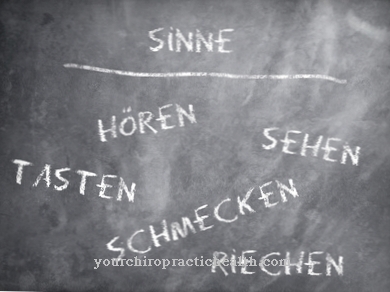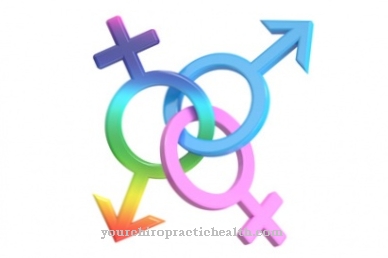The Laugh is an innate form of expression and a natural reflex for reducing stress and for the recovery of the individual as a whole. The brain reflexively responds to sensory stimuli when laughing with commands to contract certain muscles. Laughing in inadequate situations can have a disease value and indicate mental disorders.
What is the laugh?

Laughter is an innate body reflex and a natural form of expression that is only given to humans in this form. Laughing corresponds to either a knee-jerk reaction to amusing situations or a knee-jerk defensive behavior. Impending social conflicts and anxiety can be alleviated by laughing, for example.
It is believed that laughing originally corresponded to a threatening gesture to demonstrate strength, which animals also express by baring their teeth. However, within a human community, laughter has always had a connecting function.
Laughter as a body reflex occurs involuntarily as soon as the sensory nerves transmit a stimulus to the brain. This sensory stimulus is transmitted from the brain to the nerve endings of certain muscles. As a result of this reflex transmission, the laughing muscles are contracted. This contraction is, so to speak, a compensatory reflex to certain sensations.
Unlike many other reflexes, laughter can largely be held back through self-control. On the other hand, the reflex movement can easily result in an involuntary spasm known as a laughing spasm.
Function & task
Laughter relieves the burden. It is used for communication, group formation and sometimes even as a weapon. Strong sensory stimuli are stress for the body. This stress can be reduced by laughing. People also demonstrate their current emotional state unmistakably and non-verbally through laughter. It can also weaken negative feelings about laughing.
Laughing together with other people brings people together. However, laughing as a group often makes individuals outside the group feel threatened. Accordingly, laughter has many different functions and effects.
The process in the body remains largely the same. When you laugh, it is mainly the breathing movement that changes.The exhalation takes place in rapid thrusting movements. Breathing in, on the other hand, takes accelerated and deep breaths.
The breathing air reaches almost 100 km / h in the lungs. Three to four times more oxygen penetrates into the lungs. The brain reflexively triggers this breathing movement in response to sensory stimuli.
In addition, it sends contraction commands to the facial muscles. The gap in the mouth widens and the corners of the mouth rise due to contractions of the zygomatic muscle. The eyebrows are also raised, the nostrils widen, and the eyes are narrowed. The vocal cords vibrate while laughing and the diaphragm is moved rhythmically. Like any emotional situation, laughter can also stimulate the tear glands, which then release tears of laughter.
The laugh reflex causes a total of 17 facial muscles and a total of around 80 body muscles to contract. The leg and bladder muscles are relaxed during these contractions. From this context comes the expression that you pee your pants with laughter.
As a result of the altered breathing, the blood circulation is stimulated while laughing and the pulse rises. Laughter strengthens the cardiovascular system. The immune system also benefits from laughing fits. After a laughing attack there are measurably more killer cells in the blood, which protect people against viruses in particular. The immunoglobulin concentration also increases. Above all, these protein bodies help to avoid infections caused by injuries.
Laughing increases the body's defenses. Stress hormones decrease. Happiness hormones such as endorphins are released and relaxation sets in. Laughing also stimulates digestion. Laughing also relieves pain through the production of happiness hormones and anti-inflammatory substances in the body.
Illnesses & ailments
Strong fits of laughter can turn into health-threatening areas despite their actually health-promoting effects. When there is food or liquid in the mouth during a laughing attack, these substances are often inhaled.
Headaches are also often described in connection with fits of laughter, presumably due to abnormal breathing. Hematomas in the rectus abdominis muscle are just as common as headaches in extreme fits of laughter. A pneumothorax in the lungs has been observed in isolated cases. For people with cardiac arrhythmias, fits of laughter can be fatal.
Despite these risks, laughter is still rated as healthy overall, as the complications and complaints mentioned occur very rarely. For these reasons, laughter is often used in treatment methods to this day. On some children's wards in hospitals, for example, clowns make the young patients laugh and thus contribute to a faster recovery - also because a healthy psyche promotes physical health.
Actual laughter therapy sometimes takes place as part of psychotherapeutic treatments. Psychotherapists sometimes try to reduce their patients' fears. Laughter therapy is often recommended for patients with chronic illnesses in particular.
On the other hand, laughter itself can also have a disease value and first prompt you to consult a psychotherapist. For some mental disorders, abnormal laughing behavior is an indicator. Schizoaffective disorders can manifest themselves, for example, in a regular laugh reflex at sad news and a crying fit in funny situations. These phenomena are also referred to as inadequate affect impulses. At what point inadequate affects actually point to a disease can only be assessed in individual cases and thus in the context of the personality and experiences of those affected.









.jpg)



.jpg)



.jpg)







.jpg)


